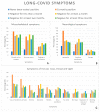Long-COVID Syndrome? A Study on the Persistence of Neurological, Psychological and Physiological Symptoms
- PMID: 34068009
- PMCID: PMC8152255
- DOI: 10.3390/healthcare9050575
Long-COVID Syndrome? A Study on the Persistence of Neurological, Psychological and Physiological Symptoms
Abstract
Background: Emerging aspects of the Covid-19 clinical presentation are its long-term effects, which are characteristic of the so-called "long COVID". The aim of the present study was to investigate the prevalence of physical, psychological, and sleep disturbances and the quality of life in the general population during the ongoing pandemic.
Methods: This study, based on an online survey, collected demographic data, information related to COVID-19, sleep disturbances, and quality of life data from 507 individuals. The level of sleep disturbances and quality of life was assessed through the Insomnia Severity Index (ISI) and the EuroQol-5D (EQ-5D), respectively.
Results: In total, 507 individuals (M = 91 and F = 416 women) completed the online survey. The main symptoms associated with "long COVID" were headache, fatigue, muscle aches/myalgia, articular pains, cognitive impairment, loss of concentration, and loss of smell. Additionally, the subjects showed significant levels of insomnia (p < 0.05) and an overall reduced quality of life (p < 0.05).
Conclusions: The results of the study appear in line with recent publications, but uncertainty regarding the definition and specific features of "long COVID" remains. Further studies are needed in order to better define the clinical presentation of the "long COVID" condition and related targeted treatments.
Keywords: COVID-19; insomnia; long COVID; long-haul COVID; quality of life.
Conflict of interest statement
The authors declare that the research was conducted in the absence of any commercial or financial relationships that could be construed as a potential conflict of interest.
Figures




References
LinkOut - more resources
Full Text Sources

